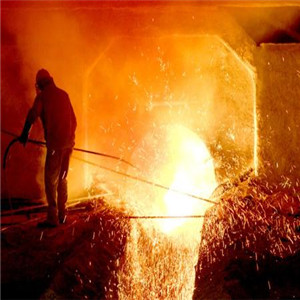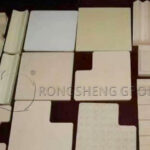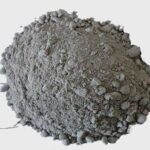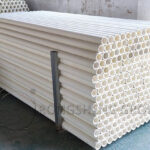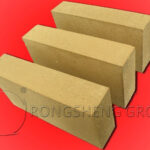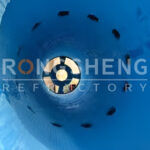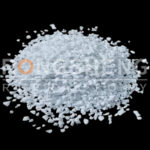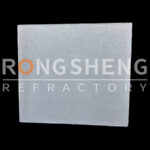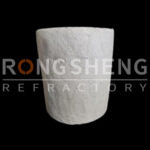Blast furnace is a kind of vertical type thermal equipment for continuous iron smelting in high temperature and reduction atmosphere , which uses blasted hot air to make coke burn and reduct molten iron ore to metal iron. From top to bottom, blast furnace can be divided in to furnace throat, furnace body, furnace bosh, furnace hearth and furnace bottom.
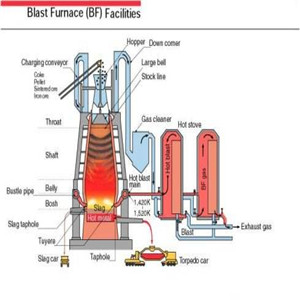
- Furnace Throat
Furnace throat is the part where should endure impulsion and abrasion of fed material, so high density high alumina bricks are usually used. But this brick can’t serve enough long time, abrasion resistant casted steel board is adopted to protect the bricks.
- Furnace shaft upper and middle part
The temperature at furnace upper and middle part is normally only 400~800℃, without slay formation and nearly no slag corrosion. Main damages to this part are impaction of fed material, abrasion of ascending dust, permeation of alkaline gas and zinc gas, carbon sediment. Clay bricks are usually used in this part, but with the development of long service life blast furnace, high alumina bricks and silimanite bricks which have better abrasion resistance and spall resistance are used in this part.
- Furnace shaft lower part
The temperature at this part is higher, a large amount of slag is formed at this part, accompanied with material abrasion, ascending gas fluxing and basic metal steam corrosion, so high class clay bricks, high alumina bricks and silicon nitride bonded silicon carbide bricks or Sialon bonded corundum bricks which have good slag resistance, alkali resistance, abrasion resistance and excellent high temperature strength are used at this part.
- Furnace belly
The temperature of this part reaches to 1400~1600℃, large quantity of molten slay are formed here, slag corrosion is very severe. What’s more, K and Na steam corrosion is serious, dust containing hot gas can cause fluxing and corrosion to material used in this part. In past times, clay bricks and high alumina bricks are usually used at this part. Now large scale blast furnaces usually use silicon nitride bonded silicon carbide bricks and reaction bonded silicon carbide bricks. There is also a trend of using Sialon bonded corundum bricks in this part. Alumina carbon bricks or micro pore alumina carbon bricks have an increased using proportion in middle and small blast furnace.
- Furnace bosh
The temperature of furnace bosh can reach to 1600℃~1650℃, slag consistency continue to decrease and thus have severer damage to furnace lining, as well as air current fluxing, material abrasion, basic steam corrosion and carbon sediment. So the quality of refractory materials used in this part should be enhanced. Earlier, high alumina bricks and corundum bricks are usually used here, now silicon carbide brick is a better replacement.
- Furnace hearth and furnace bottom
Upper furnace hearth where approaches tuyere, has a temperature between 1700℃~2000℃. Furnace bottom temperature is usually between 1450℃~1500℃. Furnace hearth is the part where corrosion to lining is severest, so tuyere usually uses silimanite bricks, corundum castable and graphite based stopping material. Nowadays, silicon carbide based refractory material are more often used in turere, while All2O3-SiC-C bricks or carbon blocks are more and more popularly used at tap hole. Furnace bottom is mainly exposed to the damage of iron liquid permeation and iron liquid corrosion to carbon bricks. Now, furnace bottom mainly uses high density, good thermal conductivity and corrosion resistant graphite bricks and micro pore carbon bricks. Ceramic cups, as a newly invented refractory material, are used as the lining of furnace bottom and furnace hearth, which includes sialon bonded corundum, corundum mullite bricks and synthesized mullite bricks, etc.
- Tuyere zone
This part’s temperature is over 2000℃ and suffers great thermal stress, such as frication, air current & molten liquid impaction and other physical damage, alkali, zinc and carbon sediment and other chemical corrosion. Nowadays, silicon carbide materials and sialon bonded corundum material which have excellent alkali resistance and high strength have replaced traditional clay bricks and silimanite bricks.
